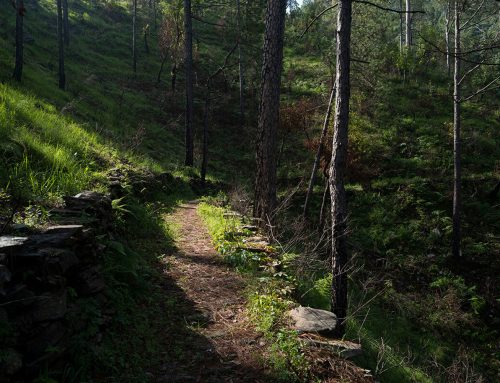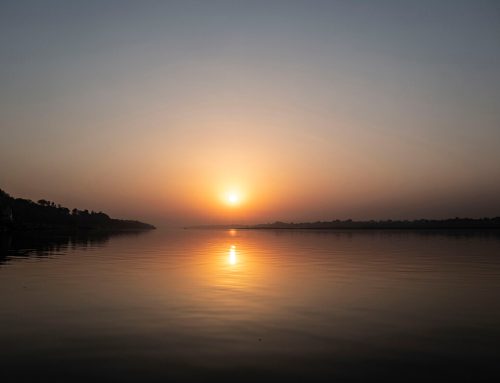Spinning the Wheel of Dharma with Chamtrul Rinpoche
Tibet has been producing awakened beings for centuries, like an assembly line, and I suspect that Chamtrul Rinpoche Lobsang Gyatso is one of them. He was born in in 1963 in Golok, Eastern Tibet and is recognized as the 3rd reincarnation of Chamtrul Pema Nangsel Dorje. Chamtrul Rinpoche is a Khenpo (Ph.D. in Buddhist philosophy) and came to India in 1996. I attend his teachings each afternoon at the Zilnon Kagye Ling Nyingma Monastery, a glorious mountainside perch illuminated by the late afternoon sun. He sits like an immoveable Buddha behind his desk, dressed in the traditional yellow shirt and burgundy robes, flanked by bookshelves containing silk-covered volumes of the sacred Tibetan Kangyur manuscript, rows of small Buddhas, photographs and odd paraphernalia like a crystal Eiffel Tower. The room is beautiful with thangkas hanging on the walls, a Tibetan carpet covering the floor and meditation cushions to sit on. To his side is a table full of gifts, stacked silk katas, an offering mandala, as well as a large crystal ball through which I can see his reflection inside.

Above his head is a photo of an old thin lama, sitting on a rock, surrounded by a rainbow. Refracted rays of light stream in through the windows and, at other times, there are intense thunderstorms. It’s an intimate and powerful place and I arrive early to simply sit in his presence. Each week, Rinpoche teaches a different aspect of the dharma, all of which are part of the Mahayana Buddhist path, but specifically the alchemical tantric Vajrayana path that is said to be the direct path to enlightenment over one lifetime. I study The Four Noble Truths, Vajrasattva, and Emptiness and Compassion. It requires intense concentration to absorb this extremely complex philosophy, and sit on the floor for two hours. By the end of each week, almost all the students have disappeared. Although I understand almost nothing, I’m captivated by everything he says.
I cannot possibly do justice to Rinpoche’s patient and elaborate teachings that lead us through logical Buddhist arguments that deconstruct concepts of self, form and time to prove that nothing inherently exists outside our perception of them, and that this fundamental misunderstanding is what leads to our suffering. He patiently explains that we are trapped in this worldly realm of endless cycle of birth and death (samsara) due to impure perceptions. He reminds us that Siddhartha Gautama’s (Shakymuni Buddha) most profound realisation is that all compounded phenomenon (things and experience) are impermanent and subject to change, except for pure awareness that is unchangeable and permanent. If we understand this, the whole Vajrayana path makes sense.
“Whatever is impermanent is subject to change. Whatever is subject to change is subject to suffering.”
—The Buddha
The Four Noble Truths lays down the ground, or path, to understand why we suffer and how to stop suffering. He says that once we know that suffering exists we must eliminate it by removing the causes of suffering. Suffering is not of dependent on external forces, but on what we have done previously – karma – and continue to do through our habitual patterns, non-virtuous acts and negative emotions, all that lead to mental defilement that obscures our true Buddha Nature and compounds suffering. Of course, one might ask, if nothing inherently exists, neither god, Buddha or self, then what is ‘it’ that knows the nature of impermanence, dissatisfaction, selflessness and who determines what is virtuous or non-virtuous? The cause of suffering is ignorance – our profound misunderstanding of the nature of life. Ignorance obscures true reality and binds us to a world of illusion. Fortunately, we can diminish our suffering if we realise that karma and defilements take place within us. I really understand this on a theoretical level and try to put it into practice. I sit in meditation for hours in front of Guru Rinpoche and Avalokiteswara in the Namgyal Monastery.
Often it feels like my mind is a fly stuck in honey, trying to detach itself from the same thoughts. I think of myself as a witness, observing this process with non-attachment and non-judgment, as if I were a psychiatrist examining someone else’s mind. I can see my habitual thought patterns that lead to self-cherishing, clinging to the ego, and even my attachment to the belief that this Buddhist path really works. In life, whenever a challenging situation arises, I try to create space between it and my reaction to it. I try not to stir up emotions like anger, desire, jealously, pride and react in a way that disturbs the mind. And this is very tempting. Instead, I just watch these thoughts, rather than engage with them, like an alchemist transforming negative emotions into a useful mind. My ego withers and for a brief moment the precious quality of humility floods in my heart. I begin to realise that thoughts cannot bind me, hold me, or grasp me. They are like clouds, coming and going, without bothering the sky.

I sign up for another course with Chamtrul Rinpoche on Bodhichitta, or cultivating the enlightened mind, something that is at the heart of the Mahayana school. He refers to The Way of the Boddhisattva, written by the 8th C saint and scholar, Shantideva, who encourages us to act with generosity and kindness, and dedicate the merits of our actions for the benefit of all other beings, and by doing so collect the merit and wisdom that we need for Buddhahood. Sometimes this sounds a bit like putting the ‘fear of god’ into people, that if we don’t act in a virtuous way that will we be destined to one of the horrendous Buddhist hell realms. So our motivation has to be pure. Compassion is the cornerstone of Buddhist path. I have to admit that I really struggle with compassion. No problem with dogs. I look into their eyes, there is pure heart connection, and I melt. The trouble lies with humans. Each of us manifest the situation we’re in, so sometimes it’s difficult to be compassionate when really I think they’re idiots and deserve the fruit of their actions. I ask Rinpoche about my lack of compassion and he reminds me that it’s all Buddha nature and what I observe in them is in fact my own projection, so I need more compassion for myself.
Despite our best intentions to be virtuous, selfishness and negative emotions still present obstacles on the path. The best tantric remedy is Vajrasattva, the Buddha of Purification. Rinpoche describes Vajrasattva and his consort as sitting in tantric bliss about an elbow’s length above my head, their bodies luminous and empty, intangible, like the reflection of the moon in water or a rainbow. This luminosity represents the glow of our Buddha nature. I visualize a flow of light falling from their mystical union into my crown chakra, an irresistible flood of nectar washes away all physical illnesses in a stream of puss, rotten blood, spiders, toads, fish, scorpions, and all harmful actions and obscurations as black liquid, dust, smoke, clouds and vapour, through the pores of my skin, lower orifices and feet, as an offering to all beings that I owe a karmic debt. Rays of light radiate and luminescent mantras spin, and I imagine Vajrasattva dissolving into me in an act of non-dualism, understanding that there is no external deity. I must become utterly absorbed to the point where I become the deity, and no longer feel the presence of ‘I’ doing the practice. It’s not a game; it’s about transforming my very being. Even though I’m just a beginner and get stuck continually, I honestly feel this kind of intense concentration makes me feel lighter and more pure. One time, I felt a presence of Vajrasattva inside of me and, in his honour, flowed him through my astanga practice. Supposedly, these gods (that don’t exist) enjoy the sensations of embodiment of flesh.
When I first encountered Tibetan Buddhism, I was really alienated by the deities. I come from the Canadian prairies, a place that taught me to appreciate subtle beauty of vast expanse and the majesty of the Canadian Rockies. I grew up largely atheist and a committed existentialist. I thought Tibetan deities were gods and could not relate to the highly ornate and seemingly baroque imagery. I preferred to watch my breath, Vipassana style. Now I understand their purpose. In the Tantric system, mantra and deity are tools to train the mind to become a Buddha and to possess the necessary compassion and wisdom to be of genuine service to the world. They make the mind subtle and blissful, necessary qualities to see the Buddha nature of our own mind. Rinpoche says, “A blissful mind is a very subtle mind and that kind of mind looking at emptiness is very different thing than the gross mind looking at emptiness and that is why one cultivates bliss.”
For sure, I need more bliss to grasp the vast, subtle mind of our teacher and his detailed machinations on Emptiness and Compassion. On the Vajrayana path both conventional truth and ultimate truth exist, as well as different kinds of beings – yogis, gods (supreme beings), human beings and hungry ghosts. He says, “A human will perceive a substance as water, while a hungry ghost will see it as puss (water burns their throat), and a supreme being will see nectar. It all depends on our capacity. Yogis are considered even more pure than gods and perceive not just the nectar, but also the deity. They see everything as omniscient, primordial wisdom and see through the delusion of solidity into space and energy. This is why almost all tantric rituals have an element of purification to eliminate the obscurations that prevent us from seeing things how they really are.” Of course, all these states are just representations of our mind.
Ordinary humans only seem to have the capacity to see objects as sold and real, and this is a result of our mistaken perception. Because we perceive the world through our senses and these create imprints or impressions, – ‘sense objects,’ our experience of the world is entirely subjective, and hence lead us back to this false notion of ‘I” that we believe is real and permanent. This is the great illusion. External appearance is really just a mental projection experienced by the mind. While it’s true from the ‘conventional truth’ perspective that a mountain won’t vanish if we turn away (and, in fact, it’s useful to say it exists to facilitate communication in the relative world), but seen through the gaze of ‘ultimate truth’ by those with pure vision, all objects break down into quark-like particles and are a shimmering dance of energy.
I’ve always been fascinated with metaphysical speculation both in Buddhist and India yogic philosophy. (Not that I get it.) In the Yoga Sutras, Patanjali states that no two people see an object in the same way. Neuroscientists also say that we can never experience an object directly, but only as a reflection of light and shadow on the retina. It’s not existent, just a reflection of the mind. When objects are projected onto ordinary perception as light, motion and mass, they arise purely in relation to a self that is itself an empty construct. Science attributes awareness to neuronal activity in the brain and the rest of the central and peripheral nervous systems, yet awareness, per se, does not seem to reside in the neurons themselves but in the converted patterns of energy they evoke. Everything that we experience, including the body and its sense organs, and the sensations, thoughts, emotions and memory resulting from our consciousness, is different from pure awareness. Therefore, everything that we think of as ‘I’ – mental, physical, emotional, and spiritual – is impermanent and subject to cause and effect. Only pure awareness, or primordial wisdom, is infinite, with no beginning or end, and exists beyond time. It is intangible, impersonal and inconceivable.

Rinpoche asks us, “Where does this is ‘I’ exist? Is it found in our physical form or beyond?” When we look at an object, we can never find the object itself. “He goes on to prove that the foundation of the body doesn’t exist. He says, “The body is comprised of arms, legs, skin and bones, but there is no one thing that is the body. It’s only a sum of its parts. It’s only imputed on the form of the body. Does is the hand exist? No. The finger is not the hand, nor the fingernail. If you analyze it logically, in detail, you see that all physical forms break down until you get to what modern physics calls a ‘quark’, the smallest part of the atom. Buddhists realised this 3,000 years ago and call it the ‘particle-less particle’. There is space between the quarks – shivering waves of energy, but they never touch. This pure energy is ‘emptiness’ and that is the ultimate truth.”
He explains that when we experience the world through our senses, we only ever find objects of desire; not the Self. As long as we desire anything, it leads us back to a false notion of ‘I’ that we cling to. Suffering arises from attachment to desire. Self-grasping, or ego-clinging, obscures the innate emptiness of the Buddha mind that is always pure, clear and luminous, with thoughts and emotions that are like clouds covering a clear, blue sky. This Buddha Nature exists within all of us and we are capable of moving through the obscurations and delusions of samsaric existence to realise primordial wisdom –Dharmakaya – and attain liberation, become awakened. One entire class is dedicated to the 37 different stages of enlightenment.

Rinpoche introduces another fascinating concept. Apparently, things only exist in inter-dependence or relationships with everything else. He explains: “We cannot think of ‘dark’ except by thinking of ‘light’. We cannot think of ‘time’ without reference to ‘space.’ It’s like Einstein’s theory of Relativity: we cannot think of anything except in contrast and in relationship with something else. If you don’t compare things, nothing can be bigger or smaller than anything else.”
I ask him if this is how the psychic powers of the Maha Siddhis manifest, where realised beings transform their illusory body into the size of an atom or as large as a mountain, can become infinitely heavy or weightless as in levitation, physically manifest out of thin air or, like the Tibetan Lung-gompa runners, fly through time and space. He shares a story about how the great yogi saint, Milarepa, used to lie down on the sky to prove the idea that tangibility is all perception, and how when the king of Tibet offered Padmasambhava gold (instead of body, speech and mind) he scoffed and manifested heaps of gold out of thin air. So, yes, it is possible to materialise thought into physical form, but the omniscience of Buddha is beyond the ordinary mind.
“All worldly pursuits have but the one unavoidable end, which is sorrow: acquisitions end in dispersion; buildings in destruction; meetings in separation; births in death. Knowing this, one should, from the very first, renounce acquisition and heaping up, and building, and meeting; and faithful to the commands of an eminent guru, set about realizing the Truth (which has no birth or death).” – Milarepa
Milarepa statue






